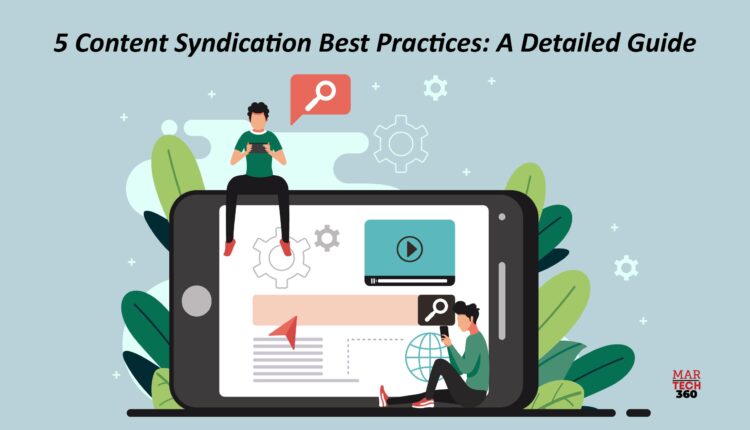This article contains a list of 5 content syndication best practices and how to do them.
According to researchers, 79% of marketers prefer using at least one vendor for effective syndication.
You can write and market the best article in the world, but if it fails to reach your target audience, it is of no use. Content syndication involves repurposing and distributing to multiple channels with due credit so it reaches more people—most importantly, the right people.
It’s like letting other stores sell your products, but instead of products, it’s your content that helps you reach a bigger audience. Let’s delve in.
What is Content Syndication?
The practice of reposting the same information—a blog post, a video, an infographic, etc.—on one or more websites is known as content syndication. Every publication, regardless of size, likes syndicating content since it allows them to serve their audience with new information. This strategy helps the original writers as well as promotes their work to an entirely novel audience.
5 Content Syndication Best Practices
 With the right practices and strategies, content syndication can offer numerous benefits, regardless of whether it’s you syndicating your article on another relevant website or publishing someone’s syndicated content on your website.
With the right practices and strategies, content syndication can offer numerous benefits, regardless of whether it’s you syndicating your article on another relevant website or publishing someone’s syndicated content on your website.
Below are the five content syndication best practices every marketer should follow:
Content Syndication to Other Websites
-
Choose Websites With Massive Followings And Greater Domain Authority
Making your information accessible to a larger audience is the primary goal of syndication. Naturally, choosing syndication partners with a significantly larger fan base than yourself is essential for this.
You should always ensure that the website where you are syndicating the content has a higher domain authority than yours.
This is how a website with more domain authority might link to you inbound. This is called a backlink, and it works like “we trust this site’s credibility.” As a result, having a backlink from a reputable website raises the significance of your page. According to a Backlinko analysis, the most significant element that correlated with Google rankings was the number of domains linking to a page.
-
Determine Who Your Ideal Customer Base
After determining and establishing your target audience, it’s essential to decide which syndication partners to choose.
It won’t make sense for a sports magazine to syndicate its content to a food-based website. In these situations, syndicating the content won’t be beneficial. It is also essential that you choose websites that are related to your target audience when choosing syndication partners.
Choosing these partners will increase your traffic as well as your chances of conversion.
-
Reduce the Length of Your Posts
It is a good idea to upload some of your content when syndicating it and then include a link from the article or page to your original website page.
Therefore, publishing a portion of your article rather than the full post or blog increases your chances of consistently ranking higher than the websites where you have submitted your content.
-
Make Sure the Website Is Properly Attributed
Search engines should still identify your content as original even if you republish it.
It is essential that the third-party website properly credits your website for any content it may have created.
This is necessary to avoid having your content viewed as duplicated and incurring penalties.
By including the “rel=canonical” tag in your syndicated post, you may direct Google to the content’s source.
By using this tag, you gain visibility as the provider of the original content and gain access to the links that the syndicated content generates.
-
Time Out Before Content Syndication Best Practices
It would be a good idea to give yourself some time between publishing the content and syndicating it, even if there is no damage in syndicating your work right away.
The interval of time guarantees that your initial article has sufficient time to become popular on its own.
After a predetermined amount of time, syndicating your original pieces will help them become more well-known and attract more traffic and rankings.
Also Read: Content Amplification: The Definitive Guide To Drive Traffic In 2024
Content Syndication Best Practices for Hosting Syndicated Articles
-
 Assign Due Credit to the Original Source
Assign Due Credit to the Original Source
If you are hosting syndicated content, you must provide due credit to the original content creator by mentioning the original source.
Content duplication can lower the ranks of your website
By mentioning the original author of the information on your syndicated page, you may prevent duplicate content from being identified and maintain the search engine rating of your website.
-
Have A High Proportion Of Original Content To Syndicated Content
Syndicated content should never take precedence over your original content on your website if you want to keep your reputation as a content provider intact.
About 90% of the content on your website should be original, with the other 10% coming from syndicated sources.
-
Add a No-Index tag to your pages: Content Syndication Best Practices
In addition to properly crediting the original author, classifying such pages as no-index is another method of avoiding Google’s penalty for duplicate content. Google will not index these pages due to the no-index tag; therefore, they will not show up in the search results.
-
Partition Your Original Content And Content Syndication Best Practices
Search results won’t show up for pages that have syndicated content marked as no-index. What purpose does such syndicated content serve in this instance, then?
These pages are still viewable on the website itself, even if they don’t show up in search results.
You can designate a distinct area to publish just your website’s syndicated content. The syndicated information you post on your website still requires you to provide credit for where it came from.
The procedures mentioned above must be followed to benefit from content syndication, regardless of whether you are hosting content from another website on your own or syndicating your own content on a third-party website.
Example of Content Syndication Best Practices
Now that you know what to do and what not to do, let’s see a real example of Buffer’s syndication strategy
Guest posting- Greater Authority, awareness and Traffic – Republishing pitches – Syndication
Buffer established connections with major content publishing sites through the utilization of guest posts. Then Buffer made contact with those websites proposing the idea of content syndication.
Here’s an email template on how you can reach out to companies.
 What are the Benefits of Content Syndication?
What are the Benefits of Content Syndication?
Content syndication best practices enable you to project your content to new audiences which helps to maximize ROI (return on investment) in content creation.
You can reach new audiences by distributing content through syndicating. to get the most out of your content creation effort.
Increase brand recognition among your target audience by collaborating with digital publications, industry influencers, and partners who distribute relevant information. Additionally, create your brand as a reliable and knowledgeable voice in your field.
Furthermore, your website can have a link included by the publisher. It will help your SEO by generating referral traffic. Google views some kinds of external links as a reliable source of credibility.
The possibility of content syndication not showing up in Google search results is one possible issue. At least not in the way you want it to be published.
Google does not wish to provide users with irrelevant results. Thus, the version that it determines to be “most appropriate for users in each given search” will be displayed.
It’s possible that’s not the version you want displayed on search engine results pages (SERPs).
That might be problematic in certain situations, but if you adhere to a few fundamental best practices, the likelihood of this problem occurring can be minimized.
Quick Tip: Incorporate content syndication with other content marketing initiatives. Thus, you’re not depending just on content that Google might consider redundant.
How to Syndicate Your Content?
Content syndication doesn’t have to be rocket science, follow the simple steps mentioned below.
- Republish your greatest or best-performing content on websites with high domain authority.
- Syndicate previous content on websites that are similar to yours in terms of viewership and authority.
- Write a guest post for a larger publication and syndicate it on LinkedIn, Medium, or your own website afterward.
- Become visible on websites that automatically syndicate information.
- Utilize paid services such as Taboola and Outbrain to have your work published in major magazines.
Tip for Guest posts: Search your keyword + guest posts on Google to find the list of companies that accept guest article requests.
Final Takeaway
When you first start, your primary goal should be to get as much exposure as possible.
For this, web content syndication is fantastic. However, you must first demonstrate your writing abilities to convince top websites like Huff Post, Fast Company, The Next Web, and others to reprint your work. Writing guest blogs is an easy way to accomplish this.
A strong writing portfolio is nearly always the first step in any successful content syndication plan.
Reach out to some of the most prominent blogs in your niche about guest postings before committing time to content syndication. This will increase the success of your content syndication.


Comments are closed.